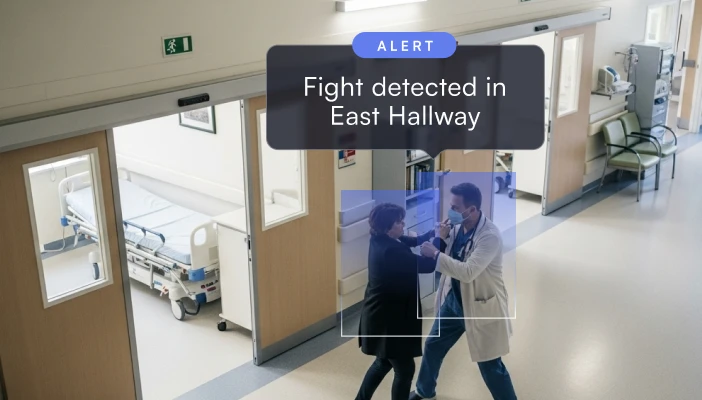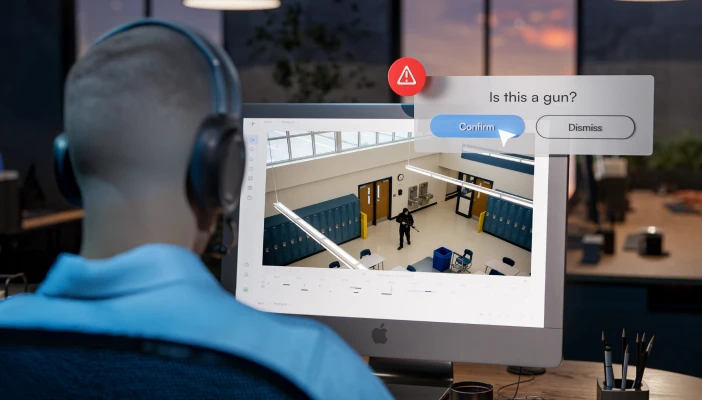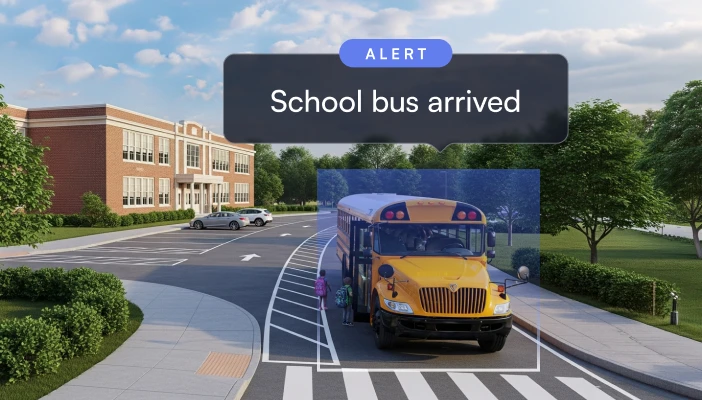Running physical security in a healthcare environment isn’t getting easier.
You’re balancing staff safety, patient privacy, visitor flow, and compliance—often with limited personnel and aging infrastructure. Cameras are everywhere, but most simply record footage instead of helping your team prevent or respond to incidents.
That’s where AI video security comes in. It’s not about replacing your team or your hardware, it’s about making both smarter.
With the right platform, healthcare organizations can layer intelligent AI on top of existing cameras to detect threats earlier, respond faster, and simplify compliance.
Key Highlights
- AI transforms video security in healthcare from passive recording to proactive intelligence that detects threats and compliance risks in real time.
- Violence and safety pressures are rising, with healthcare workers five times more likely to experience workplace violence than those in other industries, driving the need for smarter, faster incident response.
- AI video security delivers instant situational awareness by recognizing abnormal behavior, unauthorized access, and patient safety risks before they escalate.
- Automated privacy and HIPAA controls, such as masking, encryption, and audit logging, simplify compliance and protect PHI/ePHI.
Table of Contents
- Why Healthcare Needs AI Video Security
- How AI Video Security Elevates Healthcare Security
- Overcoming Common Barriers to Modernization
- The Future: Unified, Intelligent Healthcare Security
- How Lumana Helps You Get There

Why Healthcare Needs AI Video Security
Hospitals are complex ecosystems where every corner presents a unique risk:
- Emergency departments face unpredictable behavior and crowding
- Pharmacies and labs require strict access controls and audit trails
- Behavioral health units need proactive detection of aggression or self-harm risks
- Loading docks and supply rooms are targets for theft or unauthorized entry
Unfortunately, the pressure on security teams is rising. Healthcare workers are five times more likely to experience workplace violence than employees in other industries, and the sector accounts for nearly 73% of all workplace-violence incidents requiring time away from work. The American Hospital Association estimates that violence in U.S. hospitals costs the industry $18 billion annually in prevention, treatment, lost productivity, and security measures.
Against that backdrop, many security leaders are still managing static cameras, siloed systems, and limited budgets. Investigations take hours. Compliance reviews are manual and time-consuming. When incidents occur, executives expect answers immediately.
AI video security helps you deliver those answers. By adding AI to the cameras you already have, it helps teams detect risk sooner, respond faster, and produce audit-ready evidence without disrupting care.
How AI Video Security Elevates Healthcare Security
AI transforms video from a passive recording tool into an active intelligence layer. By analyzing live video feeds and detecting risk patterns in real time, healthcare facilities gain the situational awareness needed to act quickly and confidently.
The value shows up in a few critical capabilities you can deploy right away.
Real-Time Situational Awareness
AI continuously scans video feeds for patterns and anomalies, sending instant alerts when it detects something out of place. Whether it’s a patient wandering, tailgating into restricted areas, aggression in a waiting room, or door propping near exits, your team is alerted and can intervene before issues escalate.
No Rip-and-Replace Required
Modern AI platforms integrate with your existing IP cameras, adding advanced capabilities without the cost or disruption of replacing hardware. The result is automated monitoring, intelligent alert rules, and centralized visibility using the infrastructure you already own.
Faster Investigations with Natural-Language Search
When leadership or compliance teams need information fast, AI-powered search eliminates hours of manual review. Type “show me who entered the pharmacy after 10 pm” and review relevant clips within seconds.
Automatic Compliance and Privacy Controls
AI tools designed for healthcare support HIPAA compliance by automating privacy masking, encryption, and audit logging. Sensitive areas remain protected while security teams maintain evidentiary quality and meet documentation standards with less effort.
Smarter Resource Allocation
AI helps teams operate more efficiently by surfacing issues earlier and simplifying reporting. Dashboards highlight traffic trends, policy adherence, and response metrics, data that supports staffing decisions, policy updates, and budget justification.
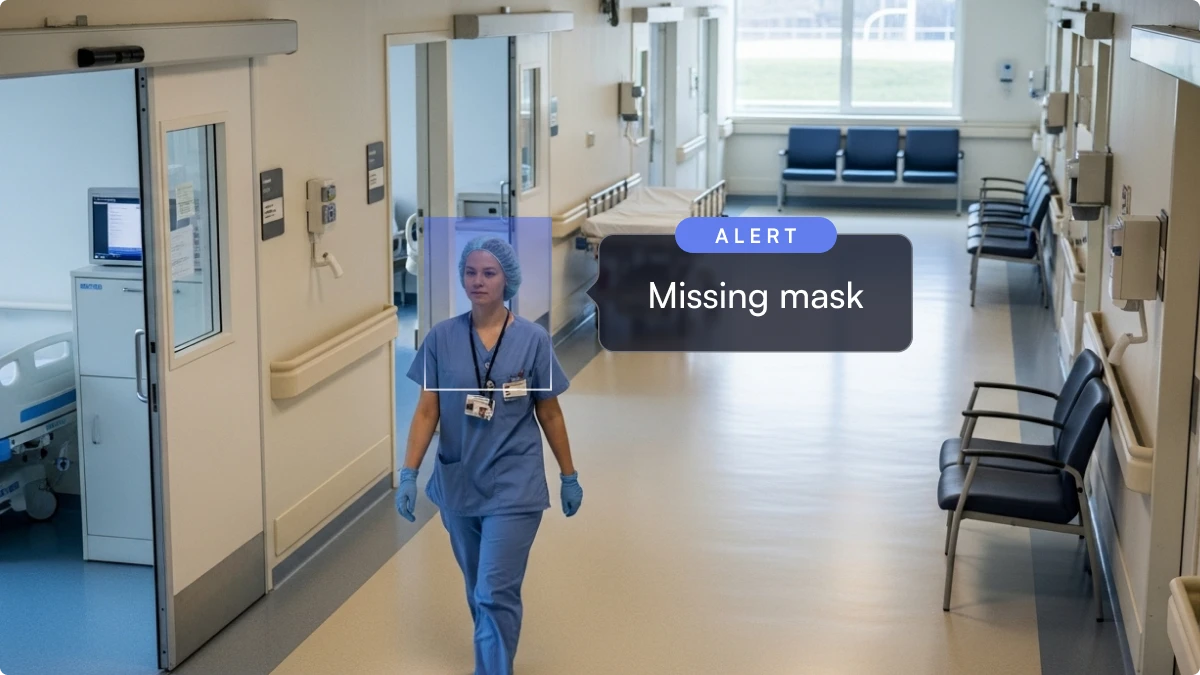
Overcoming Common Barriers to Modernization
Security leaders have had good reasons to be cautious. Past projects often meant rip-and-replace costs, downtime risk during go-lives, alert fatigue from noisy or inaccurate analytics, vendor lock-in, heavy training burdens, unclear ROI, and open questions about HIPAA liability, data residency, and IT bandwidth.
The latest generation of AI video security solutions is different. They’re purpose-built for healthcare’s realities and designed to work within existing constraints.
- Integration: Connect to existing VMS, access control, and identity systems without re-wiring your stack.
- Accuracy and noise: Behavior-based models and tunable policies reduce false alerts and focus teams on what matters.
- Reliability and change management: Edge processing and phased rollouts keep operations running while teams adopt new workflows.
- Privacy and compliance: Encryption, masking, role-scoped access, and audit logs support HIPAA requirements.
- Scalability and ROI: Start with one site or use case, validate impact, then expand as results become clear.
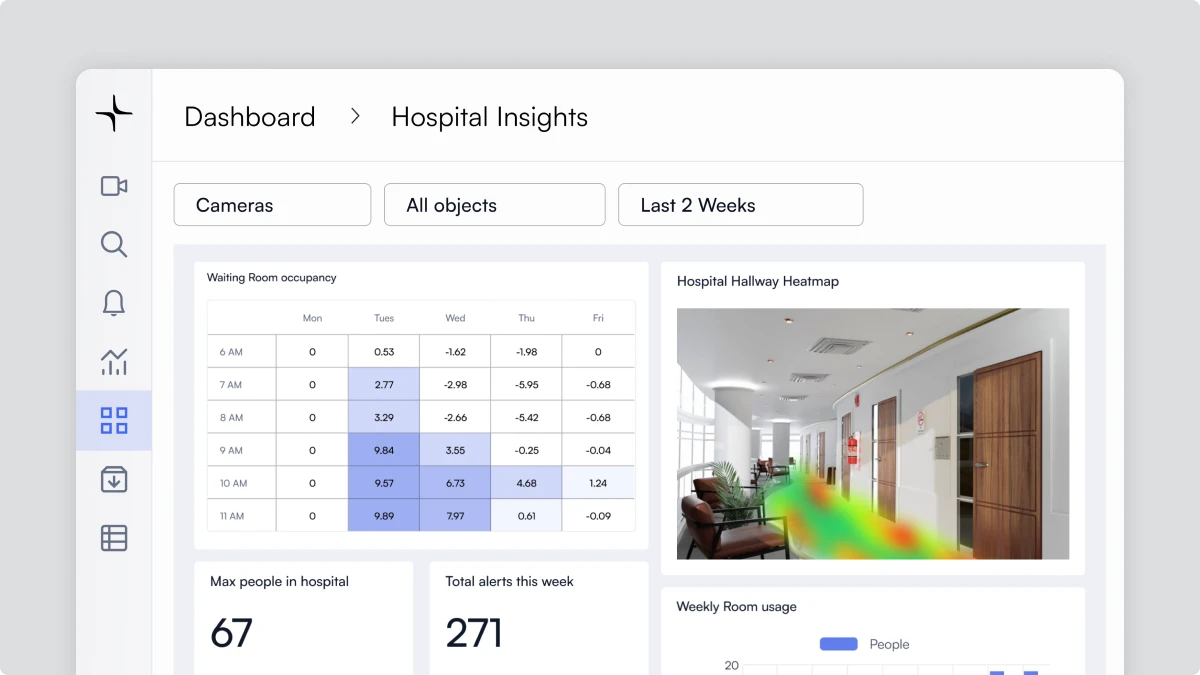
The Future: Unified, Intelligent Healthcare Security
Healthcare security is shifting from static infrastructure to dynamic intelligence. AI will soon unify video, access control, and sensor data into a single operational layer that correlates badge swipes, environmental readings, and live video to deliver context-rich insights and automated responses.
The result is faster response, fewer blind spots, and stronger compliance. Systems won’t just record what happened; they’ll help you act on what’s happening now and how to improve in the future.
And this future isn’t years away, it’s available today.
How Lumana Helps You Get There
Lumana brings AI video security to healthcare with technology built to enhance, not replace, your current systems. Our hybrid-cloud platform adds real-time intelligence, advanced privacy protection, and unified visibility to every connected camera.
Why Security Leaders Choose Lumana
- Works with existing IP cameras: modernize without rip-and-replace.
- Real-time AI alerts: 100+ event types, from violence detection to restricted-area access and PPE compliance.
- Hybrid-cloud reliability: edge processing for sub-second analytics, cloud management for scale and resilience.
- Privacy built in: HIPAA-aligned masking, encryption, and role-based access.
- Search in seconds: layered and natural-language queries replace manual scrubbing.
- Operational insight: dashboards for occupancy, staffing, and risk trends across sites.
With Lumana, healthcare facilities move from passive monitoring to proactive, intelligent security, improving safety, reducing risk, and simplifying compliance while maximizing the systems already in place.
Ready to modernize your healthcare security?
Request a demo today to experience AI video security in action.



